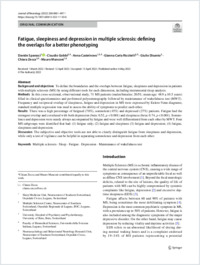Fatigue, sleepiness and depression in multiple sclerosis : defining the overlaps for a better phenotyping
- Sparasci, Davide ORCID Sleep Medicine Unit, Neurocenter of Southern Switzerland, Ospedale Civico, Lugano, Switzerland
- Gobbi, Claudio ORCID Multiple Sclerosis Center, Neurocenter of Southern Switzerland, Ospedale Regionale di Lugano, EOC, Lugano, Switzerland ; Faculty of Biomedical Sciences, Università della Svizzera italiana, Switzerland
- Castelnovo, Anna ORCID Sleep Medicine Unit, Neurocenter of Southern Switzerland, Ospedale Civico, Lugano, Switzerland ; University Hospital of Psychiatry and Psychotherapy, University of Bern, Bern, Switzerland ; Faculty of Biomedical Sciences, Università della Svizzera italiana, Switzerland
- Riccitelli, Gianna Carla Multiple Sclerosis Center, Neurocenter of Southern Switzerland, Ospedale Regionale di Lugano, EOC, Lugano, Switzerland ; Neuropsychology and Behavioural Neurology Research Unit, Neurocenter of Southern Switzerland, Ospedale Civico, Lugano, Switzerland
- Disanto, Giulio Multiple Sclerosis Center, Neurocenter of Southern Switzerland, Ospedale Regionale di Lugano, EOC, Lugano, Switzerland
- Zecca, Chiara ORCID Multiple Sclerosis Center, Neurocenter of Southern Switzerland, Ospedale Regionale di Lugano, EOC, Lugano, Switzerland ; Faculty of Biomedical Sciences, Università della Svizzera italiana, Switzerland
- Manconi, Mauro ORCID Sleep Medicine Unit, Neurocenter of Southern Switzerland, Ospedale Civico, Lugano, Switzerland ; Faculty of Biomedical Sciences, Università della Svizzera italiana, Switzerland
- 2022
Published in:
- Journal of neurology . - 2022, vol. 269, p. 4961–4971
English
Background and objectives: To define the boundaries and the overlaps between fatigue, sleepiness and depression in patients with multiple sclerosis (MS) by using different tools for each dimension, including instrumental sleep analysis. Methods: In this cross-sectional, observational study, 71 MS patients (males/females: 20/51; mean age: 48.9 ± 10.5 years) filled in clinical questionnaires and performed polysomnography followed by maintenance of wakefulness test (MWT). Frequency and reciprocal overlap of sleepiness, fatigue and depression in MS were expressed by Eulero-Venn diagrams; standard multiple regression was used to assess the ability of symptoms to predict each other. Results: There was a high percentage of fatigued (70%), somnolent (45%) and depressed (27%) patients. Fatigue had the strongest overlap and correlated with both depression (beta: 0.52, p < 0.001) and sleepiness (beta: 0.74, p < 0.001). Somno- lence and depression were nearly always accompanied by fatigue and were well differentiated from each other by MWT. Four MS subgroups were identified that had: (1) fatigue only; (2) fatigue and sleepiness (3) fatigue and depression; (4) fatigue, sleepiness and depression. Discussion: The subjective and objective tools are not able to clearly distinguish fatigue from sleepiness and depression, while only a test of vigilance can be helpful in separating somnolence and depression from each other.
- Collections
- Language
-
- English
- Classification
- Medicine
- License
- Open access status
- hybrid
- Identifiers
-
- DOI 10.1007/s00415-022-11143-6
- ARK ark:/12658/srd1326716
- Persistent URL
- https://n2t.net/ark:/12658/srd1326716
Statistics
Document views: 80
File downloads:
- Zecca_2022_Spri_jneur: 108
